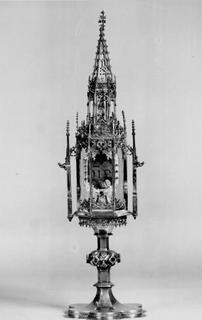Honored as a saint, she became the protector of those with mental illness. From an early date, the sick, and especially the mentally ill, came to Geel to seek cures, although it was not until around 1270 that Hendrik III Berthout founded a hospital, or gasthuis, at Geel, under the spiritual patronage of the Virgin Mary and Saint Dymphna. Willem van Henegouw, the Bishop of Kamerijk (the diocese to which Geel formerly belonged), acknowledged the foundation in 1286 and granted statutes to the brothers and sisters there who cared for the sick.

The hospital was called the Sint-Dimpnagasthuis and was adjacent to the Sint-Elisabethgasthuis, with which it later merged. A fire destroyed the Church of Saint Dymphna in 1489 but it was rebuilt and consecrated in 1532. The church, as well as the hospital for housing the sick and convent for housing the Gasthuiszusters, still stand. The buildings date from the fifteenth through the eighteenth century, because the cult of Saint Dymphna and the hospital grew continually, and the buildings, correspondingly, had to be augmented. Geel continues to attract mentally ill people from Flanders and is considered very progressive in its care for the mentally ill.
Pilgrims traveled to Geel to see Dymphna’s relics. There they were able to obtain lead-tin stamped pilgrim badges. One, for example depicts the saint holding a sword and vanquishing her father in the form of a deranged beast. Christ, crucified between Mary and John, appears over her head like the choir screen in a church, while the structure of the object as a whole is reminiscent of the cross-section of a church, with a nave and flanking side aisles.

One of my favorite objects still housed in the church of St. Dymphna is this reliquary in the form of an ostensorium, to display a piece of red stone found in the tomb of St. Dymphna. Made primarily of silver, it was produced some time in the sixteenth century. The red “stone” (which is really a piece of earthenware baked from red clay) has some letters carved in it [apparently “DI(M)P”] and a hole at the top so that it can hang from a cord. According to legend, a priest would hang the object around the neck of a sick person and pronounce certain words with supernatural power in order to affect a cure.
2 comments:
Although Saint Dymphna's father was obviously a nasty sort, he certainly had an extraordinary sense of smell. Is there any correlation?
Bloodhound Afficionado
Usually it's a negative correlation, eg, Sueskind's _Perfume_. The stalker bit is the problem, eg, Rabbit Proof Fence. If their story were taking place today (Hollywood version), he'd find her with her credit card bills.
Post a Comment